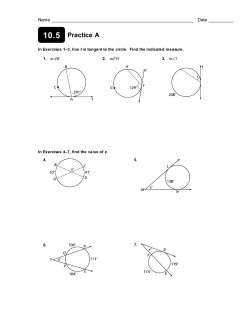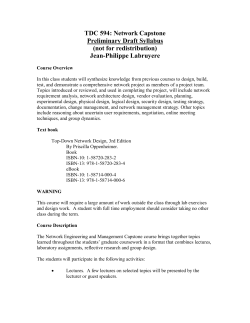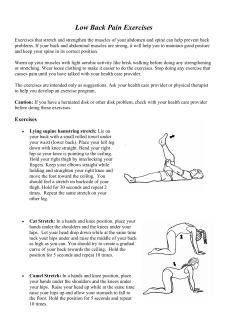
The influence on balance capacity of the practice environment of ludic recreational activities
Available online at www.sciencedirect.com ScienceDirect Procedia - Social and Behavioral Sciences 137 (2014) 11 – 16 SEC-IASR 2013 The influence on balance capacity of the practice environment of ludic recreational activities Bădău Adela 1†, Ungur Ramona Natalia¹, Iconomescu Teodora Mihaela², Bădău Dana¹ 1 University of Medicine and Pharmacy, 38 Gheorghe Marinescu Street, Târgu Mures, România 2 “Dunărea de Jos” University of Galati, 46 Domneasca Street, Galati, România Abstract The practice of motor activities in a variety of environments, such as the aquatic one, with characteristics which positively influence the motor and morphological indexes as well as the selection of the most efficient and most favorable methods, along with the usage of innovative materials, represents a valuable advantage in improving the motor capacity. We consider it essential and advisable to improve the balance, which is highly under-evaluated during childhood, or at least to maintain it at certain levels, by supporting the motor capacity. The study identifies the influence level of balance, by practicing different types of ludic - recreational activities during teenage years and in various environments: on the ground and in the water. © 2014 2014 The The Authors. Authors. Published Publishedby byElsevier ElsevierLtd. Ltd.This is an open access article under the CC BY-NC-ND license © Selection and peer-review under responsibility of the Sports, Education, Culture-Interdisciplinary Approaches in Scientific (http://creativecommons.org/licenses/by-nc-nd/3.0/). Research and Conference. Selection peer-review under responsibility of the Sports, Education, Culture-Interdisciplinary Approaches in Scientific Research Conference. Keywords: unipodal balance, aqua-gym, aqua-pullpush-gym, applied exercises, exercises for general physical development. 1. Introduction Among the physical properties of the environment, viscosity imposes biological and motor adaptations on the body executing movements during ludic recreational programs, with focus on posture adjustment and muscle balance improvement. Many times, when practicing motor ludic recreational activities, the muscular balance development is not the monitored objective, but the secondary result of the improvement of other motor qualities. The practice of ludic recreational water activities implies a series of characteristics with obvious effects on the sanogenetic, social and psychic level as well as on the motor level, improving the main components of the motor capacity. † Badau Adela Tel.: +0-072-326-1514 E-mail address: kenzoadela@yahoo.com 1877-0428 © 2014 The Authors. Published by Elsevier Ltd. This is an open access article under the CC BY-NC-ND license (http://creativecommons.org/licenses/by-nc-nd/3.0/). Selection and peer-review under responsibility of the Sports, Education, Culture-Interdisciplinary Approaches in Scientific Research Conference. doi:10.1016/j.sbspro.2014.05.245 12 Bădău Adela et al. / Procedia - Social and Behavioral Sciences 137 (2014) 11 – 16 “The specific physical and mechanical means of water environment allow the individual to move under a mechanical structure of total or partial imponderability, which can occur without the partial or total effect of body weight” (Vilas–Boas, 1977; Figueiras, 2005). “Water is 12 times thicker than air and that is why it produces a higher movement resistance, as compared to the movement executed on the ground” [8]. Di Masi [4] considers that when we move inside a pool, we are aware that the resistance varies according to the positioning of body segments and of the execution speed that we define. This phenomenon occurs because executing a water movement leads to the creation of a “high pressure area” in front of the body segment as well as a low pressure area behind it, and, as a result, a high water flow is created inside this low pressure area. Water balance is influenced by the homogenous resistance around the body, to which the hydro gravity action is added, requiring a noticeable mechanic input of the antagonist and agonist muscles with each movement. “The physical properties of water, the physiological effects of the immersion and the exercises have a positive influence on balance control” [7]. Barbosa T. [3], [14] adds the fact that “the body balance within water environment depends on the relation between the floating power and gravity.” The author also states that there is an interesting characteristic of the gravity center (CG) and the floating centre (CF). On articulate bodies like the human body, their location varies according to the body’s position on water surface as well as the arrangement of body segments. As a consequence, the author distinguishes “three types of water balance: stable, instable and neutral. The stable balance is achieved when the gravity centre and the floating centre are aligned, without these two points concurring on their spatial arrangement. An example of stable balance position is represented by the jelly fish. The instable balance is reached when there is no alignment between the two centers: gravitational and floating. The neutral balance is reached when the two centers concur. In order to attain this type of balance, the human body has to be symmetrical on its various plans and should also be homogenously built” [3]. “Ideally, the executant has to keep a constant stable balance for a better efficiency in executing the exercises and in preventing injuries (the traction vector represents the vertical projection of the weight vector, having therefore different positions of the applied forces)” [3]. Balance-based studies, with subjects relatively close in age with the subjects of our research, were carried out on 22 healthy female students (aged 20.6 ± 1.0) from other study specialties, on a period of 8 weeks, comprising two classes per week of 30 minutes [9]; this led to positive results especially for the physical condition, with a 0.017 parameter improvement of force, flexibility and balance. Water-based recreational activities have as components: an autotelic feature with intrinsic results that they produce on the personal satisfaction of all those who practice them, autoplastic feature motivating their practice in order to achieve harmony of the body and adaptability to new situations, as well as a sanogenetic feature determined by motor motions which require aerobe efforts, by muscular, energetic and psychic strains, with a view to improving all functions of the body. Ludic recreational activities have the following features: physiological-by the nature of exercises, educational-by the applied methods, biological-by the generated effects, social-by the society’s manner of organization. Aqua-gym and aqua-pullpush-gym embody “the modern tendencies of physical exercise practice through the combination of various simple and complex action systems, adapted to the positive influences of the water environment” [1]. Aqua-pullpush-gym represents an innovative method of motor education technology, being adaptable to particularities, specific to age and training level, as well as to individual and group preferences, contributing to optimum modification of behaviors and physical capacities, by exclusive utilization of pull/push paddles push [2]. Action means applied during water-based activities involve: straight jumps, exercises with switch of execution direction, takeoffs with various landings, exercises with one leg support, etc. Bădău Adela et al. / Procedia - Social and Behavioral Sciences 137 (2014) 11 – 16 2. Hypothesis The research started from the premise that practicing aqua-pullpush-gym activities with the help of innovative materials which can adapt to both inferior and superior limbs, requires physical effort for body balance while executing exercises, therefore determining improvement of muscular balance. 3. Materials and methods a) Participants The research was carried out on two experimental study samples, each consisting of 24 first year female students, from the University of Medicine and Pharmacology in Târgu Mureş, with ages between 19 and 23 years old. During the 50 minute-long physical education classes held twice a week throughout the school year 2011-2012, the experimental group E1, made up of female students from the Faculty of Dentistry, executed a specific program of aqua-gym activities, while the experimental group E2, made up of female students from the Faculty of Pharmacology, practiced aqua-pullpush-gym programs. The control study sample consists of 47 first year female students from the Transilvania University of Braşov, aged 19-24, from the specialties: Medicine, Sociology and Letters; during the physical education classes held in the gym, they practiced the following activities: ludic recreational activities, applied exercises, freestyle exercises for the general physical development and exercises with portable objects. b) Materials The objects used during recreational water activities offer an increased productivity to the exercises, due to the floatability factor, becoming resistant when an object immerses into water, and to the viscosity added to the environment forces [12], [6]. Some studies discovered that trainings with progressive over heaviness based on certain objects usage led to better results both on the ground and in water – many times, significant differences being registered between them [5]. Aqua-gym uses materials like: rubber dumbbells, palmers, gussets, etc. some used for support, others for effort increase, as part of the determined length program. Aqua-pullpush-gym (picture 1) uses exclusively innovative materials called pull-push paddles, which are characterized by a hydrodynamic shape like a flower, with five “petals” of 37cm in diameter, on the center having an ergonomic handle to hold, slightly rough to prevent slipping. These can also be fixed on the soles in order to execute exercises for the inferior members, having also an accessory called fixopié, looking like sandals, provided with two clips disposed on complementary directions in order to facilitate fixing with a twisting action. 13 14 Bădău Adela et al. / Procedia - Social and Behavioral Sciences 137 (2014) 11 – 16 Due to its wide contact surface with the water and also to the small free space between the petals, the paddle can take, during its energetic pull actions, a hydrodynamic shape like a jelly fish, this representing the position with the most stable balance. c) Methods The applied methods were: the bibliographic study, the observation, the study, tests, mathematical and statistical study and graphic representation. The mathematical data were processed with the help of SPSS 20, calculating the Independent Student Test, the arithmetic mean and the standard deviation. The research enclosed an initial test at the beginning of the first semester, during the first weeks of October, after which the suggested programs were executed throughout the entire school year, followed by a final test at the end of May. For both initial (Ti) and final (Tf) tests, the unipodal balance test was applied. The technique: a standing position on one leg, the other one lifted and bended forward, the arms on the sides, with the registration of the time while this position is maintained until the first imbalance. Interpretation: the maintaining time of this balance position will be registered for both the right and the left leg. The class structure of aqua pull-push gym programs is the following: warm-up on the ground for 3-5 minutes followed by the warm-up in water with a view to getting accustomed with the environment, after which two exercises are executed during the main phase, using the pull-push paddles, first for the superior body then for the inferior body; by the end of the class, the paddles attached to the feet and hands are used. The program ends with some stretching exercises for relaxation, for about 5 minutes. The aqua pull-push gym feature is that it uses the same materials, namely the pull-push paddles during the entire length of the fundamental unit of the class, the order of the exercises taking into account the rules of the accessibility principle. Action means applied during water based activities involve: straight jumps, exercises with switch of execution direction, takeoffs with various landings, exercises with one leg support, etc. The balance exercises used in aqua-pullpush-gym are more varied due to the hand-held paddles which expand the support area during execution, allowing for a greater diversity of the execution plans. In addition to the mentioned action means, aqua-pullpush-gym creates a slight imbalance as a result of the sole-fixed paddles, requiring a significant rearrangement of all body’s axes, leading to increased effort and emphasized mobilization. The possibility of using the paddles both on the hands as well as on the soles requires mobility, balance and muscle strength. 4. Discussions and results Subsequent to the study, the samples registered between the two tests (show that) timing increases in maintaining the position both on the left as well as on the right leg, equally specific to the unipodal balance. The control group achieved, at the unipodal balance test, a difference of arithmetical means of 11.53 seconds on the left leg and 12.64 seconds on the right leg. This positive result registered by the control group was achieved as an outcome of executing applied exercises on the gymnastics bench such as: walking or running alternations with arm movement, takeoffs, rotations, as well as exercises for the general physical development, crossed jumps alternation in different directions with fast switch, at signal hooter, hanging in the balance frontally and dorsally, etc. Table 1 results obtained during the unipodal balance test with the control group and the experimental group (Aqua- gym) Trials Balance, left leg Balance, right leg * p<.05 Test TI TF TI TF Control group(n=47) x m 152,91±38,06 164,45±38,07 159,38±38,82 172,02±38,81 Experimental group(n=24) x m 153,04±54,11 193,88±54,20 161,08±54,28 202,96±54,03 t p 0,01 2,37 0,13 2,49 .991 .009* .880 .007* 15 Bădău Adela et al. / Procedia - Social and Behavioral Sciences 137 (2014) 11 – 16 Table 2 results obtained during the unipodal balance test with the control group and the experimental group (Aqua- pullpush gym) Trials Test Control group (n=47) xm Experimental group (n=24) xm t p Balance, left leg TI TF 152,91±38,06 164,45±38,07 152,71±32,51 220,46±32,65 0,02 6,45 .982 .000* Balance, right leg TI TF 159,38±38,82 172,02±38,81 160,29±31,30 228,83±31,36 0,10 6,64 .921 .000* * p<.05 The experimental aqua-gym group (Table 1) registered a more noticeable progress with a difference of arithmetical means of 40.83 seconds on the left leg and 41.88 seconds on the right leg. The highest progress was observed at the experimental group practicing aqua-pullpush-gym (Table 2) as follows: the difference of the arithmetical means between the two tests were of 67.75 seconds on the left leg and 68.54 seconds on the right leg, which is explained by the use of pull/push paddles, especially when executing complex exercises with these fixed on the soles. During the aqua-gym activity, all exercises are practiced with support on the legs, except for those executed from floating positions, while, during aqua-pullpush-gym, every movement requires, firstly, a redressing of the body’s position, due to the paddle’s shape not creating contact with the bottom of the pool when fixed on the soles, on the whole surface of the paddle, this leading to significant improvement of balance on both legs, as it can be observed from the research data. Fig 1 Graphic representation of the obtained arithmetical means during the unipodal balance test between the control group and the experimental group executing aqua-gym Fig. 2 Graphic representation of the obtained arithmetical means during the unipodal balance test between the control group and the experimental group executing aqua-pullpush-gym 16 Bădău Adela et al. / Procedia - Social and Behavioral Sciences 137 (2014) 11 – 16 It can be noticed that the results on the unipodal balance, achieved during both initial and final tests are higher for the right leg, no matter the study sample. As a consequence of the obtained results, we consider that the execution of composed movements with objects for both superior and inferior limbs represents an efficient method of balance improvement, as it creates conditions of podal imbalance and, therefore, it requires posture readjustment through a significant effort imposed on the entire body. 5. Conclusions The main conclusion, after the research, is that the hypothesis is confirmed; namely, the practice of water-based ludic recreational activities can lead to balance improvement. The usage of modern designed materials, which are adaptable to both inferior and superior limbs and require sustained handling efforts, contributes, in an efficient and appropriate manner, to the increase of unipodal balance. Given the physical properties of the water environment, to which are added the most efficient action means, the unipodal balance achieves significant development during water-based ludic recreational activities as opposed to those practiced on the ground. Balance improvement has to become a constant pursuit for all specialists in this field, involved in ludic recreational activities training, both water- and ground-based, for all categories of individuals. References Bădău Adela, Ionescu Dragos, Bădău Dana (2012), “Aquagim – o metoda inovatoare de gimnastica in apa”, The Annals of “Dunarea de Jos” University of Galati, Fascicule XV,ISSN: 1454–9832, http://www.efms.ugal.ro/; p 23. Bădău A, Bădău D. (2011), Aqua-pullpush-gym- o metoda novatoare de gimnastica in apa- Ed. UniversitatiiTransilvania din Brasov, ISBN 978973-598-865-1, p 7. Barbosa T.M., Queiros T. (2005), Manual Práctico de Actividades Aquáticas e Hidroginastica, (2ª Ed.) Lisboa: Xistarca, Promoções e Piblicações Deportivas, LDA, p.104,135 Di Masi F. (2000), Hidro – PropriedadesFisicas e aspectosFisiologicos, Ed Sprint, Rio de janeiro, , p 63. Foley, A., Halbert, J., Hewitt, T. I Crotty, M. (2003), Does hydrotherapy improve strength and physical function in patients with osteoarthritis—a randomised controlled trial comparing a gym based and hydrotherapy based strengthening programme.Annals of Rheumatic Diseases, Nr. 62(12), p.1162-1167,. Gomez M. F., Ghiorzi V, Loss J. F., Gomes L. E., (2010), Caracterizaçáo das cargas de flutuaçáo de implementos de hidroginástica e hidroterapia, Revista Mackenzie de EducaçãoFísica e Esporte, Nr. 10(1): p. 64-75,. Mendez Resende S. (2007), Novo protocol de hidroterapia na recuperacao do Equilibrio e prevencao de ouedasemidados, disertaţie postdoctorală, , p. 18. Murgu A.I., Bălan V., Ionescu A, Apostol A., (2007), Recuperarea afecţiunilor aparatului locomotor prin hidrokinetoterapie, Revista: Palestrica Mileniului III, Civilizaţie şi Sport Vol. VIII, Nr. 3 (29), p. 147-154, p. 148, http://www.pm3.ro/pdfs/PM3_Nr.3(29)_2007_1.pdf#page=7 Saavedra, J.M., Escalante, Y., Pino, J., De la Cruz, E. Y Rodríguez, F.A. (2006) „Aplicación de un programa de aqua-aerobic de muy corta duración (4 semanas) en la mejora de la condición física saludable en mujeres jóvenes sanas”. Apuntos EDUCACIÓN FÍSICA Y DEPORTES, Nr: 86, p. 14-21, http://articulos-apunts.edittec.com/86/es/086_014-021ES.pdf Vilas – Boas JP. (1997), Hidroginastica: Cosideracoes Biomecanicas acerca de forms alternativas de fruir o meio aquaticom, Horizonte Nr 13 (78), p. 9-11,. Figueiras T. (2005), Hidroginasticaumaactividadeparatodos. Texto de ApoioapresentadoaoInstituto Superior da Maio, p. 24.
© Copyright 2025









